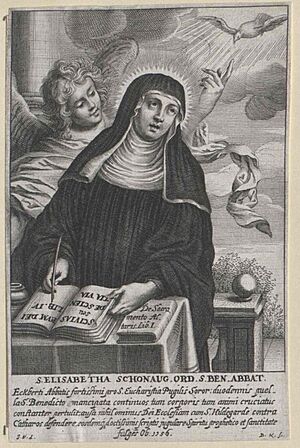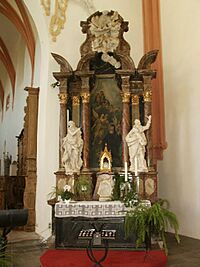Elisabeth of Schönau facts for kids
Quick facts for kids SaintElisabeth of Schönau |
|
|---|---|

Depiction of Elisabeth in a manuscript at the Austrian National Library
|
|
| Born | c. 1129 Germany |
| Died | June 18, 1164 (aged 34–35) Schönau Abbey, Strüth, Germany |
| Venerated in | Roman Catholic Church |
| Canonized | pre-congregation |
| Feast | 18 June |
Elisabeth of Schönau (born around 1129 – died June 18, 1164) was a German Benedictine nun. She was known for having many religious visions. Elisabeth became an abbess at the Schönau Abbey in Germany. People from far away, even France and England, sought her advice because of her visions.
Contents
Elisabeth's Life Story
Elisabeth was born around 1129 in the Middle Rhine area of Germany. She grew up in a family named Hartwig. She received her education at the Schönau Abbey, which was a monastery for both monks and nuns. In 1147, she officially became a Benedictine nun.
In 1157, Elisabeth became the abbess, or leader, of the nuns at the abbey. At that time, only women from noble families usually became leaders in the Benedictine order. This suggests that Elisabeth likely came from a noble background.
Early Years and Challenges
From a young age, Elisabeth was very religious. She followed the rules of her convent strictly. She also practiced mortification, which means denying oneself certain comforts for religious reasons. Between 1147 and 1152, Elisabeth became ill and felt very anxious and sad. This was due to her very strict religious practices.
Another famous nun, Hildegard of Bingen, wrote letters to Elisabeth. Hildegard advised Elisabeth to be more careful with her strict lifestyle.
Elisabeth's Visions Begin
In 1152, Elisabeth started having amazing visions. These visions often happened on Sundays or other holy days during church services. She would see Christ, the Virgin Mary, angels, or saints. They would appear to her and give her instructions.
Sometimes, she would see realistic scenes from the Bible. These included events like the Passion, Resurrection, and Ascension. It was a year after Hildegard of Bingen shared her own visions, which might have influenced Elisabeth.
Elisabeth's Passing
Elisabeth passed away on June 18, 1164. She was buried in the abbey church of St. Florin at Schönau.
Elisabeth's Writings

Elisabeth wrote down what she saw and heard during her visions on wax tablets. Her abbot, Hildelin, told her to share these experiences with her brother, Eckebert. Eckebert was a cleric, a church official, in Bonn. He helped Elisabeth by writing down and organizing her visions.
At first, Elisabeth was worried that people might think she was making things up. But she obeyed her abbot. Eckebert later became a monk at Schönau and then the abbot himself. He published all of Elisabeth's writings under her name.
The Books of Visions
Elisabeth's writings are collected in three books called "Visions." The first book is written in a very simple and natural way. The other two books are more detailed and use more complex religious words. This shows that Eckebert likely helped more with the writing of the later books.
Her works are found in a large collection of old Christian writings called the Patrologia Latina. Besides her Books of Visions, she also wrote other works.
Visions about the Cologne Martyrs
One of Elisabeth's works is called Book of Revelations on the Company of the Martyrs of Cologne. In 1106, an old Roman cemetery was found near Cologne. People believed it held the remains of Saint Ursula and her 11,000 companions. However, some bodies were of men and children, which didn't fit the story of St. Ursula.
To solve these questions, Abbot Gerlach von Deutz asked Elisabeth to use her visions. He hoped she could find out where the bodies came from. For a year, Elisabeth recorded her conversations with saints and angels. These were put together into the Book of Revelations on the Company of the Martyrs of Cologne.
In her accounts, Elisabeth identified some of the bodies. For example, she said one belonged to a "Pope Cyriacus." These stories became part of the later legends about St. Ursula.
Visions of the Virgin Mary
Another work is The Resurrection of the Blessed Virgin. This book contains Elisabeth's visions about the Virgin Mary. Once, during a church service, Elisabeth saw a vision of a queen-like woman in the sky. The woman came closer and blessed Elisabeth, telling her not to be afraid.
After receiving communion, Elisabeth had another vision. She saw the Virgin Mary standing by the altar, wearing a crown. In a third text, Elisabeth describes Mary as someone who helps calm God's anger towards the world because of sin.
The Book of the Ways of God
Elisabeth also wrote The Book of the Ways of God. This book seems similar to Scivias, a famous work by Hildegard of Bingen. Elisabeth's book gives advice to all kinds of people. This includes priests, ordinary people, married people, and unmarried people.
In this book, Eckebert's influence is clear. It warns priests who are not good leaders. It also criticizes monks who pretend to be poor but are not. The book speaks against the bad habits of ordinary people and bishops who do not do their duty. It also encourages people to fight against the Cathari heresy.
Eckebert's Role in Elisabeth's Visions
Eckebert often felt it was important to understand the deeper meaning of Elisabeth's visions. He didn't just record her words. He often asked her to ask the saints and angels in her visions about religious questions.
For example, Elisabeth had a vision of a virgin surrounded by the sun. This bright light seemed to light up the whole earth. But then a dark cloud appeared, which Elisabeth described as "extremely dark and horrible." Elisabeth asked the holy Angel of God, who often appeared to her, what the dark cloud meant.
The Angel explained that the virgin represented the humanity of Jesus. The darkness showed God's anger with the world. But the brightness meant that God was still watching over the earth. Elisabeth shared this vision with Eckebert, as Abbot Hildelin had ordered.
Eckebert was confused. He didn't understand why Jesus's humanity was shown as a virgin instead of a man. Elisabeth explained that the female figure also represented the Virgin Mary. Even though Eckebert was confused, he chose to publish this vision. This shows how much he believed in his sister's experiences.
People have different opinions about Elisabeth's revelations. The church has never officially decided if they are true or not. Elisabeth herself believed her visions were from God. Her brother Eckebert also believed this. Some people, like Johannes Trithemius, thought they were real. Others, like Eusebius Amort, thought they were just Elisabeth's imagination or even tricks from the devil. This is because some parts of her visions don't match historical facts or other revelations.
Honoring Elisabeth
Because people quickly began to see Elisabeth as a saint, her bones were moved. Between 1420 and 1430, they were placed in a special chapel. This chapel was destroyed in a big fire at Schönau Abbey in 1723 and was never rebuilt.
During the Thirty Years' War, soldiers attacked Schönau Monastery. They broke into Elisabeth's grave and scattered her bones. Only her skull was saved. It is now kept in a special container called a reliquary in the church.
Every year, the church of St. Florin Schönau Monastery celebrates a special event. It is called the Elisabethen-Fest and takes place on the Sunday after June 18.
Elisabeth's Influence
Elisabeth was very popular, and many important people asked for her advice. Many learned and religious men asked her to write them letters. One monk visited Elisabeth to better understand her visions. He asked for a letter from her.
Elisabeth wrote to him and his abbot, giving them spiritual advice. She stressed the abbot's duty to guide his monks. She also wrote about the importance of living for God and not getting distracted by worldly things.
Elisabeth also wrote to powerful men even when they didn't ask. She once scolded Archbishop Hillin of Trier. She was angry that he had not told the people of Rome a divine message of judgment. She told him to "Rise up in the spirit of humility and fear of the Lord your God." Her letter showed great disappointment in the archbishop. It was clear that Elisabeth believed her Angel had spoken to her, and she was passing on God's message. She warned him that if he didn't share the message, he would suffer on judgment day. This shows her strong belief in her role as a messenger of God.
Translations of Her Works
- Modern English Translation: Elisabeth of Schönau: the complete works, translated by Anne L. Clark (New York: Paulist Press, 2000)
- Modern German translation: Die Werke der Heiligen Elisabeth von Schönau, translated by Peter Dinzelbacher (Verlag Ferdinand Schöningh, 2006) ISBN: 3-506-72937-3
- Her works have also been translated into modern Italian (1859) and French (1864). There was even a medieval Icelandic translation (around 1226–1254).
See also
- Catholic Church in Germany
- List of Catholic saints
- Saint Elisabeth of Schönau, patron saint archive
Images for kids
![]() This article incorporates text from a publication now in the public domain: Mershman, Francis (1909). "St. Elizabeth of Schönau". Catholic Encyclopedia 5. New York: Robert Appleton.
This article incorporates text from a publication now in the public domain: Mershman, Francis (1909). "St. Elizabeth of Schönau". Catholic Encyclopedia 5. New York: Robert Appleton.



